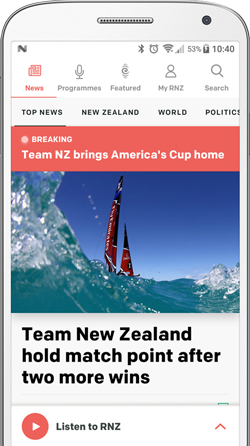
The pōwhiri for the Kāhui Taiao Tūroa conservation symposium at Maungaroa marae near Te Kaha. Photo: Supplied/Michaela Insley
Iwi-led conservation project Raukūmara Pae Maunga will receive a $6 million funding boost over the next three years from the government, something that gives the programme certainty as their Jobs for Nature funding runs out next year.
Established in 2020, Raukūmara Pae Maunga is a partnership between Ngāti Porou, Te Whānau a Apanui and the Department of Conservation which aims to restore the biodiversity of the forest in the East Cape's Raukūmara range.
It runs the largest aerial 1080 operation and the largest deer control operation in the North Island and currently employs 28 local iwi staff.
Raukūmara Pae Maunga Governor Ora Barlow (Te Whānau a Apanui, Ngāi Tai, Te Whakatōhea, Ngāti Porou) said it was one of Aotearoa's most ambitious ecological restoration programmes, largely because it was not just about the ecological goal, but a social enterprise that generated jobs and supports iwi aspirations.
"Our people are trained, the landscape is starting to respond with this very much needed large scale response that we've had in terms of applying conservation tools and seeing those gains. So the Raukūmara is forgotten no more."
Barlow said the funding would give the programme some certainty to continue after their Jobs for Nature funding ran out in 2026.
A lot of conservation projects around the country had relied on the same funding and now didn't have any next steps, she said.
"It really is a massive and a major problem in our country where tourism is the second biggest export... and tourism is reliant on our biodiversity and nature."

Raukūmara Pae Maunga governor Ora Barlow. Photo: Supplied/Ora Barlow
Barlow said it would require a national perception switch to see the amount of investment conservation required for large scale ecological restoration.
The restoration of ecosystems and the control of invasive species were ongoing work, but this funding was just part of what Raukūmara Pae Maunga needed to continue, she said.
"What we want to do in the East Cape and in the wider East Coast region is really emerge as a place with this special status driven by this nexus of economy, cultural revitalisation, mountain to ocean ecosystems, visitor experience, climate change resilience and all of that is going to take intergenerational work."
Barlow said the next steps for Raukūmara Pae Maunga included securing long-term funding partnerships, expanding restoration efforts and growing a skilled ecological workforce.
Conservation Minister Tama Potaka said Raukūmara Pae Maunga was also developing a new generation of indigenous conservation leaders - with over 1000 tamariki and rangatahi engaged in taiao learning and 14 kura involved in taiao programmes.
"Using innovative technology like DNA surveying of deer densities and advanced thermal-assisted detection technology in deer culling, Raukūmara Pae Maunga enhances New Zealand's international reputation in nature-based solutions."

The pōwhiri for the Kāhui Taiao Tūroa conservation symposium at Maungaroa marae near Te Kaha. Photo: Supplied/Michaela Insley
Kāhui Taiao Tūroa
The funding boost was announced at the Kāhui Taiao Tūroa Symposium at Te Kaha in the Bay of Plenty, a three day national gathering of iwi-led conservation projects.
"Part of the symposium's real drive is to one bring a place where Māori led approaches to conservation and development are actually really setting direction for Aotearoa," Barlow said.

The pōwhiri for the Kāhui Taiao Tūroa conservation symposium at Maungaroa marae near Te Kaha. Photo: Supplied/Michaela Insley
The theme is Tirohanga whānui, Tumanako nui or 'broad vision great hope'.
Barlow said it was about the collective ambition of Māori and a shared optimism that ecological collapse could be reversed through partnership.
For Māori it was not simply an abstract space, it was about recognising the health of nature was intrinsically tied to the health of people, she said.
"So it really matters that we understand the scale of the problem that's going on in our country."
Sign up for Ngā Pitopito Kōrero, a daily newsletter curated by our editors and delivered straight to your inbox every weekday.


